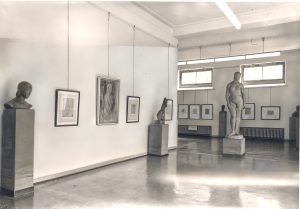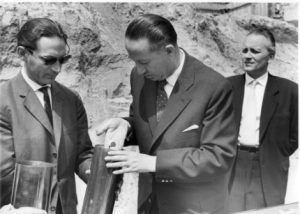History of the Lehmbruck Museum
Now more than a century old, Lehmbruck Museum can look back on a very eventful history. It is among the longest-standing art institutions in Germany, and with its array of 20th and 21st century art is one of the most important sculpture collections in Europe.
The beginnings
The foundation of the Kunstverein in 1905 laid the basis for what would later become the museum. A mere two years later, the association shouldered the responsibility for compiling a collection of contemporary art alongside its efforts in cultural history. The Böninger family, outstanding members of the Duisburg commercial world, generously made the acquisition of the first work by Wilhelm Lehmbruck possible in 1912.
1916 marked a further important step taken on the path to the foundation of the museum: The Böninger family purchased the plot of land on which the current building stands and financed the construction of a museum as well as an expansion of the collection. In 1925, founding director August Hoff developed the art museum on the basis of the Lehmbruck collection.

The Lehmbruck Collection in the town's art museum 1934-1958
One of the darkest chapters of the museum’s history followed in 1937: In the course of the Degenerate Art campaign, the Municipal Art Museum lost about 100 of the works in its collections, including pieces from Lehmbruck’s most important work phase (1910-1918). Kneeling Woman, for example, went on show in the Degenerate Art travelling exhibition and was later sold by the Nazis.
After the War
After the end of the Second World War the museum began to grow again and it soon became clear that the collection desperately needed a building of its own. In 1964, six years after construction work started, the Wilhelm Lehmbruck Museum designed by Manfred Lehmbruck was inaugurated in the Kantpark. A short while later, one of the most important foundations for the museum was established: Der Förderkreis des Wilhelm Lehmbruck Museums e. V. was established in 1968. To this very day, the Freundeskreis association – the successor organization – provides crucial support for the museum.

Mayor August Seeling (center) und Manfred Lehmbruck (right) at the groundbreaking ceremony on June 25, 1959, Photo: Friedrich Paetzold
With the collection growing continuously, the building soon required an annex. In the 1980s together with Klaus Hänsch it was again Manfred Lehmbruck who designed the extension. The newbuild almost doubled the exhibition space available. In 1987, one year after the extension is completed, the art education department was established and has since earned itself national repute.
In the new millennium
In the year 2000, two further key steps were taken: on the one hand, Stiftung Wilhelm Lehmbruck Museum was founded, on the other, Museumsverein Duisburg and Der Förderkreis des Wilhelm Lehmbruck Museums e. V. merge to form Freundeskreis Wilhelm Lehmbruck Museum e. V.
After many years of negotiations, in 2008 the estate of Wilhelm Lehmbruck was at long last given a permanent home in Duisburg. 33 sculptures, 18 paintings, 11 works in pastel, 819 drawings and 260 prints henceforth enhanced the collection, allowing Lehmbruck Museum to consolidate its status as a unique artist’s museum.